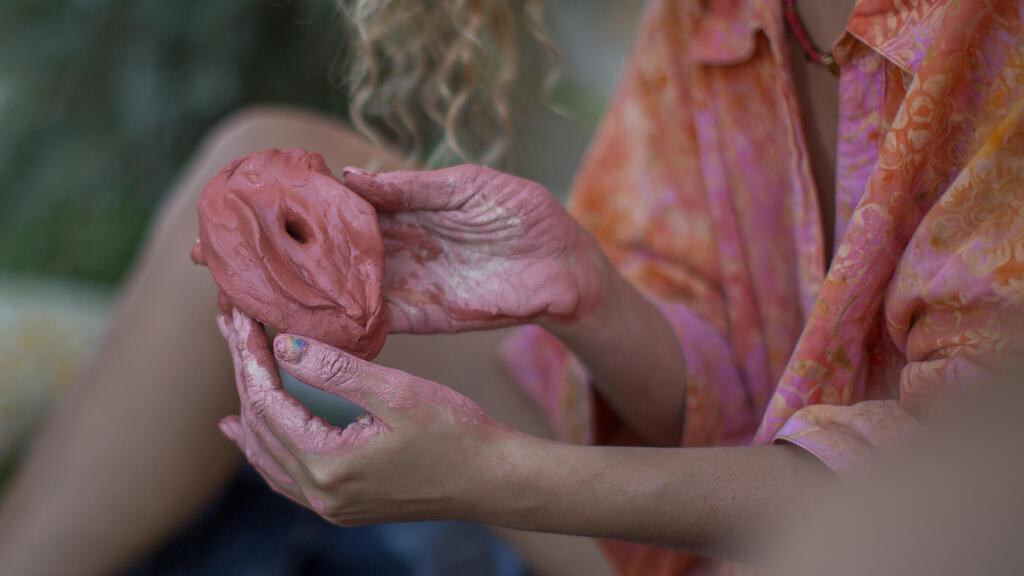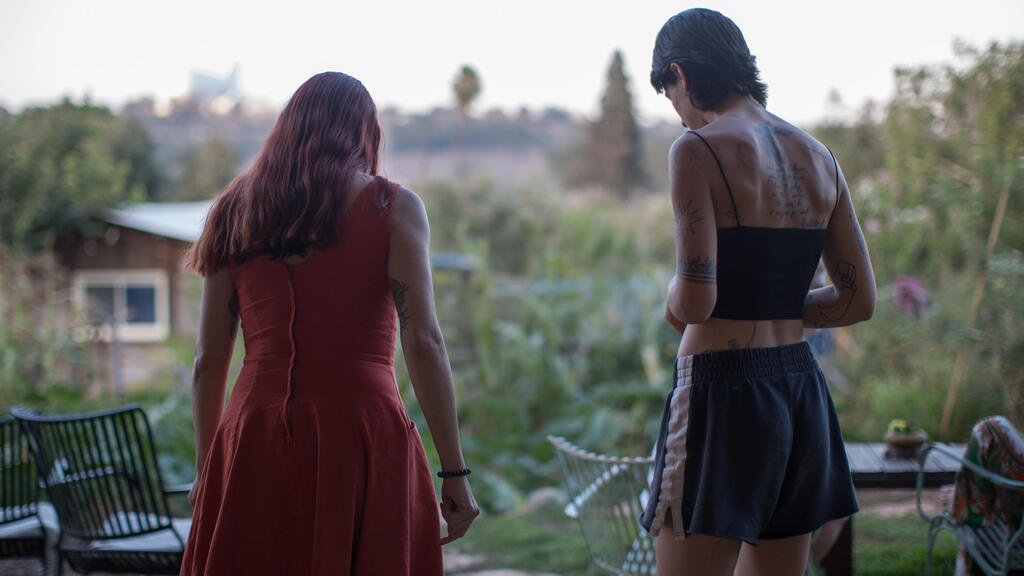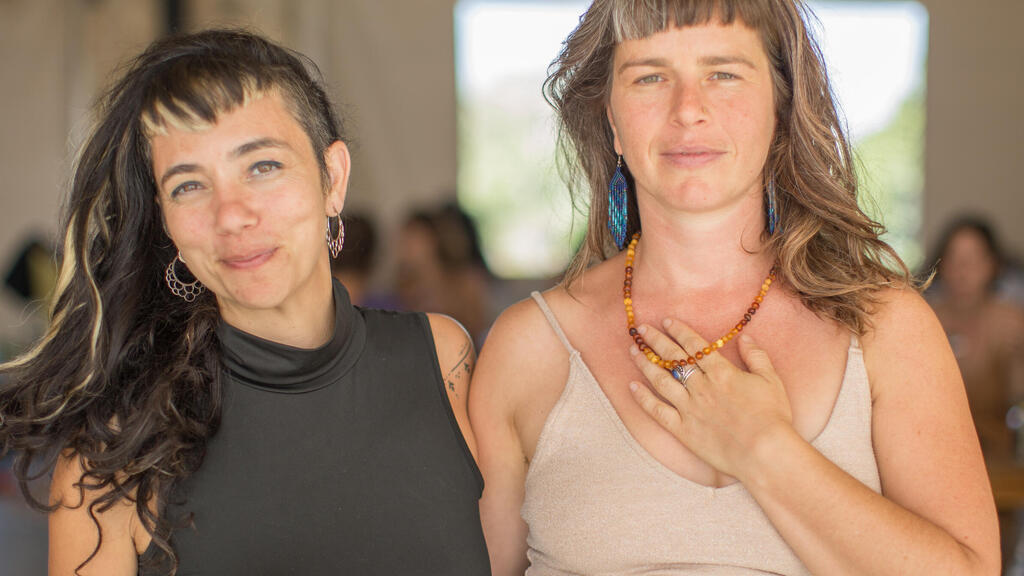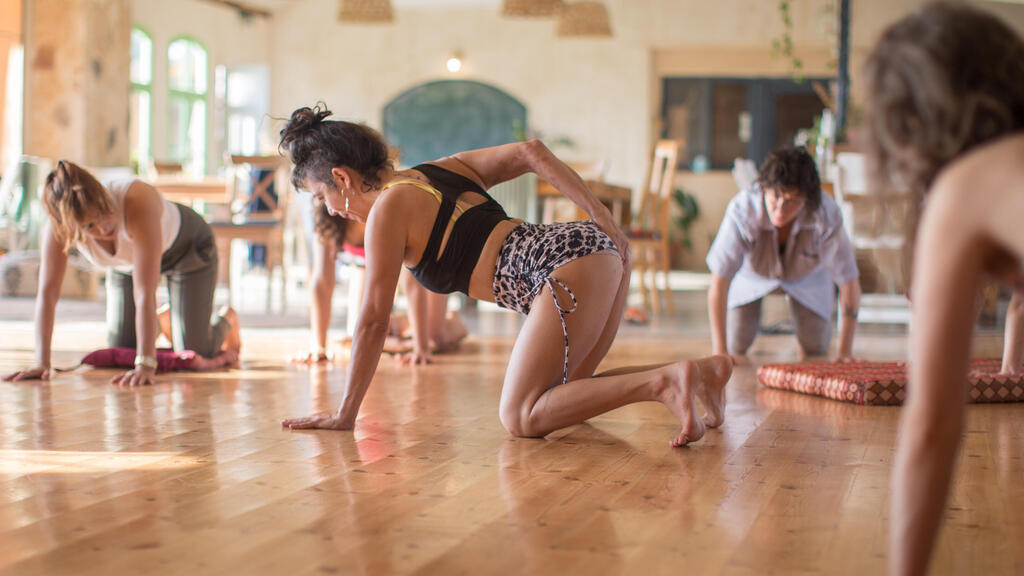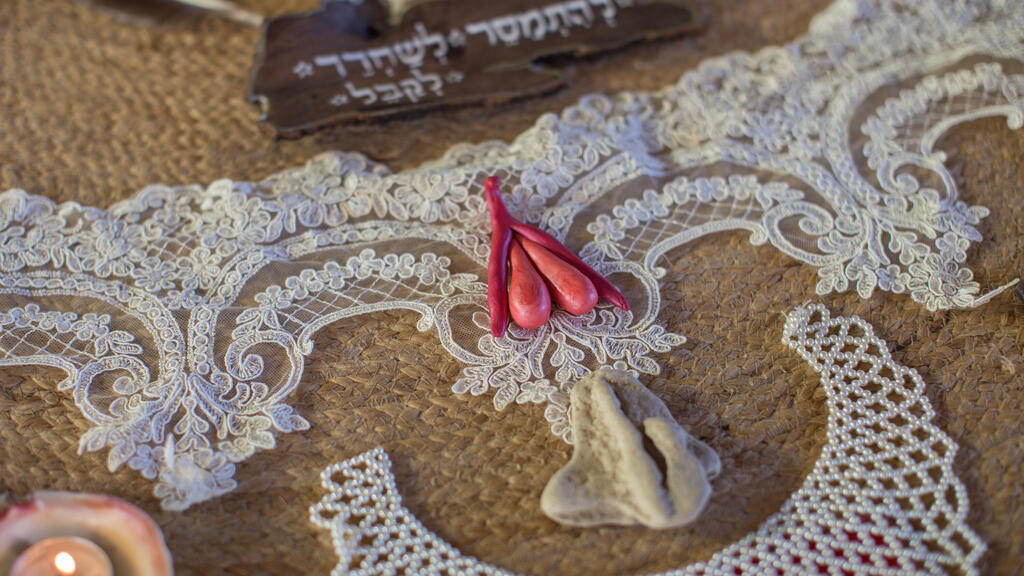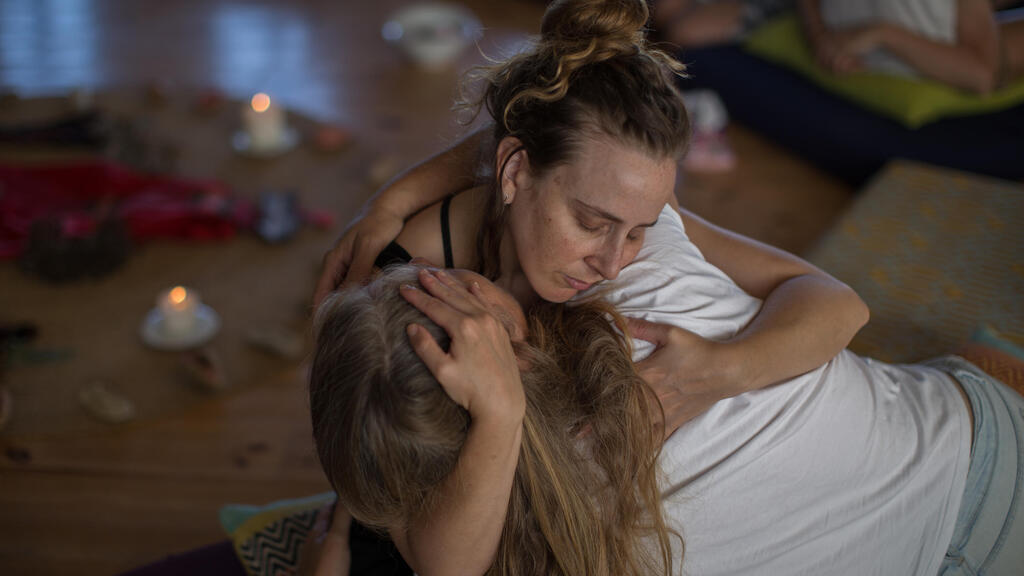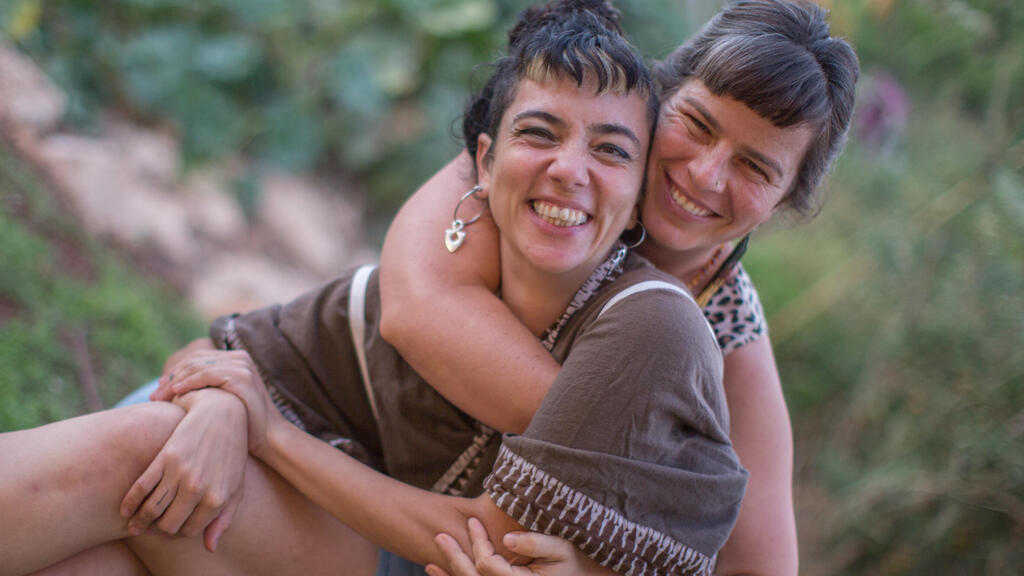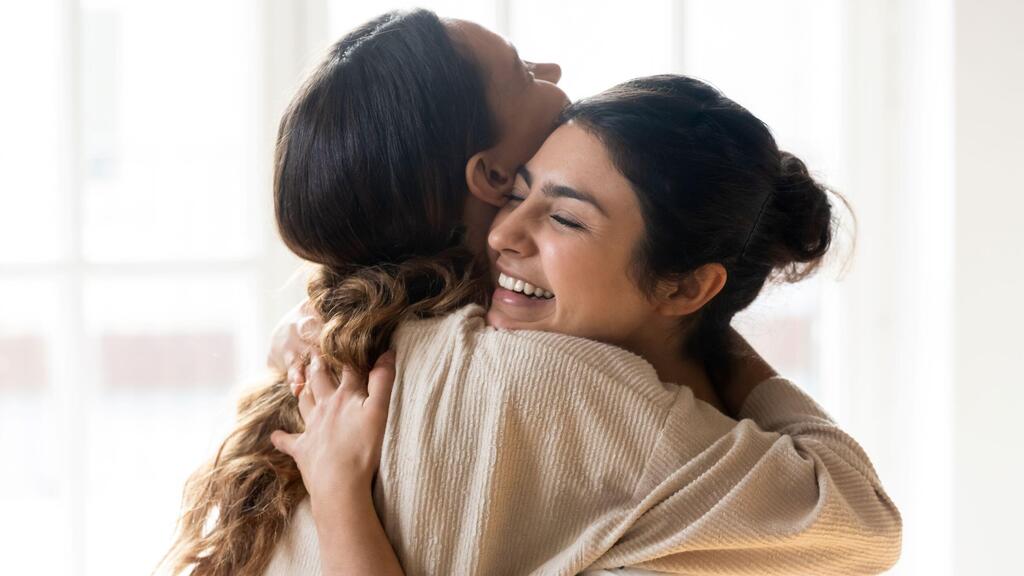Some 24 women sit in a circle in a spacious, bright and colorful workshop venue in the “Yarok Az” farm in Ilaniya in northern Israel. They shyly look at one another, knowing that over the next two days, they’ll be sharing secrets and reservations they haven’t even shared and with their best friends.
In the center of the circle, there’s a little pagan altar with colorful objects including crystals, feathers, material and candles. Adorning the foot of the altar is a piece of red satin cloth laid out forming the shape of a vagina - with a white gemstone representing the clitoris.
This “Wild Roots” weekend workshop aims to empower women by familiarizing them with their pelvic floor, its gateways, and energies in keeping with Far Eastern “Tantra” teachings. The workshop also promises no-nonsense talk about female pleasure and orgasm potential. I was intrigued and jumped at the opportunity.
The women spend the first of the three-day retreat getting to know each other. I was glad to see women ranging in age from 20-year-olds to grandmothers in their 60s. After an introductory session about why each of us had come to the retreat, we started practicing the “boundaries game.”
Familiarizing ourselves with our own boundaries is central to alternative sexuality workshops. If these boundaries are not kept responsibly, it can result in physical and emotional damage. As the workshop involves active participation, to ensure women emerge physically and emotionally unscathed, the women have to be attentive to their own bodies.
My allotted partner is asked to stand opposite me at the other end of the room, and look deeply into my eyes. We gaze tenderly at one another. It feels weird at first. People don’t look each other in the eye anymore. We generally look away, averting our gaze.
Looking deeply into someone’s eyes can be embarrassing, startling, intimate and intrusive. These workshops, however, require we be completely present - beginning with constant eye-contact.
In the second exercise, we’re told to follow our partner’s directions, instructing us to draw closer and further away from one another. This can mean getting within only a few centimeters of each other, or staying a safe meter apart- whatever feels right.
I feel I’m drowning into her huge eyes. She tells me to slowly draw nearer to her, until she tells me to stop. I’m now close enough to see her gentle facial contours. I’m very close, but not too close. We breathe together and switch roles. It’s now my turn to decide how physically close she’ll be to me and wait to see when my body feels it’s time to stop.
As evening draws near, we get to the workshop that teaches us about pleasure. The pelvic floor is a subject not talked about enough. Women who haven’t given birth don’t always know about it.
Lena Leyla, who runs the retreat with Avigayil Ruth Lev, is an erotic body massage instructor, movement teacher and licensed Pilates trainer. She tells me that her personal sexuality journey started with her efforts to cure the vaginal pain she’d feel during sex.
“Although I felt very connected to my own body, I felt a pain in my vagina when I was sexually aroused. As a Pilates and movement teacher, I didn’t understand what was going on. Pain accompanied pleasure. It was very confusing.
My journey began by carrying out abdominal and erotic body massaging on myself. I also did sessions of listening to my vagina. At some point, I realized that I was harboring sexual trauma that I ‘d experienced at the age of 15, which I ‘d forgotten and had been suppressing for over 20 years.”
“It’s called ‘somatic recall’ – when being touched in certain places evokes positive memories. Touching and being connected to the sex organ, being attentive to the pain and to my body’s own story, I learned that trauma was actually governing my sex life.”
Lena tells us that most women can ignore some of the pain that the body produces. It then magnifies to a level that it cannot be ignored. “Women forget that the pain doesn’t appear for no reason. It’s a sign that the body needs healing. I’m now super-attentive to my body and to the conversation with my vagina.“
To illustrate its sheer size, she passes around a life-like anatomic model of the pelvis. She shows us where the pelvic floor is situated and what the elastic structure inside looks like. “When we look deep into our reproductive organs, which are literally so significant that they can create and contain life, we see quite how multi-dimensional they are.
Beyond the functional aspects of periods, childbirth, sex and bowel movement, we also have access to a totally intelligent source of power, with a sensory system full of nerves. Listening and talking to this system, can change our lives."
Conscious intimacy instructor Avigayil Ruth Lev explains that “the pelvic floor, where our reproductive organs are, is the source of life-creation. The womb and ovaries are our center of life-creation. They’re not there just for reproductive purposes. We’re not just here to create a new generation. We’re independent, creative beings and we deserve to be fulfilled.”
“As we learn about our pelvic floor, vulva, vagina and uterus, we can create an inner map of our own physical and emotional wellbeing. We’ll can become connected to ourselves, to our life-force, and to our own fulfillment and self-realization. I think it’s very natural for us women to connect to the pelvic floor, its’ concealed and revealed wisdom and to the ancient knowledge stored within in the body."
The second day kicks off with Pilates and ecstatic dancing. The instructors then ask the women to share what they call their female sex organ. One woman says “pipi”. “Mine’s a pipi too” another eagerly responds. We all smile at each other as yet more infantile names are thrown around the room. “Foo-foo”, “poony”, “down there.” “We don’t call it anything. We just don’t talk about it.” Almost none of the 24 women in the circle called it a vulva or a vagina. Is it any wonder we’re ashamed of it?
Eve Ensler’s “Vagina Monologues” instantly come to mind. Starting as an off-Broadway show in 1996, the Vagina Monologues are based on interviews Ensler conducted with 200 women of varying socio-economic backgrounds. The women told the playwright about their relationships with their vaginas and about sex in general.
“In Great Neck, they call it a pussycat. A woman there told me that her mother used to tell her, ‘Don't wear panties underneath your pajamas, dear; you need to air out your pussycat.’ In Westchester they called it a pooki, in New Jersey a twat. There's ‘powderbox’, ‘derrière’, a ‘poochi’, ‘poopi‘, a ‘peepe’, a ‘poopelu’, a ‘poonani’, a ‘pal’ and a ‘piche’, ‘toadie’, ‘dee dee’, ‘nishi’, ‘dignity’.”
Ensler lists close to 30 belittling and infantile names women use for their vaginas, illustrating women’s difficulty in loving their own sexual organ.
After an historical overview detailing how the Christianization of Europe caused women draw apart from one another and from the tribe of women, Avigayil and Lena ask for our full attention and concentration as the upcoming exercise is going to be extremely intimate.
Now that we’ve gotten to know each other and we’ve learned about the pelvic floor, the next stage is getting to know our vaginas up-close, looking at it in the mirror and making friends with it.
“Patriarchal society had made us embarrassed, ashamed and afraid. We began concealing ourselves” Avigayil explains. “Most of us know don’t what our vagina looks like or what kind of touching it can bring us pleasure, how to open ourselves up to pleasure and orgasms. We’ve no idea because we haven’t been taught.”
This exercise, too reminds of Eve Ensler’s Vagina Monologues. “I interviewed a whole group of women between the age of 65 … this particular woman was 72 years old, and she had never seen her vagina.”
Vagina workshops were started in the 1970’s by sexologists and sex instructors creating safe spaces in which women could learn about their vaginas and various methods to pleasure them. The most famous was sexologist, author and sex educator, Betty Dodson, a founder of the sex-positive movement.”
Dodson, who passed away two years ago at the ripe age of 91 and starred in Gwyneth Paltrow’s wonderful Netflix series “Goop”. Back in the ’70’s, Dodson started telling women to stop being embarrassed about our vaginas, and that we should start talking openly and unapologetically about masturbation and sex toys.
Some 7,000 women participated in Dodson’s sex workshops which have continued after her death. In these workshops, women sit naked in a circle. They look at their own vaginas using hand-held mirrors. They breathe and learn how to masturbate. Dodson hoped that her workshops would help women take control of their own pleasure and sexuality.
“Female body-image is the greatest problem, and it starts with vagina” she said in an interview. In Paltrow’s program she said that she learned to love her vagina after being intimate with a guy who said to her: “I don’t understand why you don’t love your vagina. It’s an amazing organ! Plenty of women have lips like yours.”
Dodson recalled that he brought an anatomy book from home and said: “Look. Her vagina’s like yours. And this one. And this one too… “She took the book, looked at the pictures and was delighted to see that there were more women with vaginas that looked just like hers.
This defining moment in her life prompted her to set up the vagina workshops which, in time, became her life’s work and a highly lucrative business.
Betty familiarized legions of women with their vaginas and their pleasure potential. Lena and Avigayil hope to convey these very same messages here in Israel. “It’s important for women to understand that their bodies are their greatest asset and that listening and connecting with them can help them lead happy, independent lives - that they contain passion, love and pleasure.”
The next exercise is a psychodrama in a circle. Lena explains that anyone who feels the need to let out emotions raised during the workshop is invited to the center of the circle and express whatever she’s feeling. Lena would help her with whatever comes up.”
This sounds straightforward. In practice, some women bring up weighty and explosive subjects, including trauma and sexual abuse. Avigayil and Lena don’t allow the women to relive the trauma. They bring the women back to the here and now, to breathing and sensing their own bodies, keeping the space sanitized of any further potential injury.
I later ask Avigayil and Lena about the danger facing less experienced instructors when exposed to women sharing these very difficult experiences. “Secondary post-traumatic stress disorder”, sometimes known as “compassionate fatigue”, refers to a woman developing post-traumatic symptoms following exposure to a trauma experienced by another woman.
“Trauma is when something so overwhelming happens that we can’t deal with it” Avigayil explains. “A memory is etched into the body and one’s entire character rotates around it. To avoid reliving those feelings, the body can contract, going into a state of helplessness, hysteria and complete disassociation.”
“When something traumatic comes up in the group, it can be startling, but if we allow ourselves to be startled, we’ll only replicate the movement the body makes in a state of trauma. So, we work on the exact opposite movement. We stay there. We don’t flee, but rather we find the tools to heal and breathe. This lets us teach the body new methods to re-empower us. This healing applies not only to the woman in the center of the circle, but rather to all the women in the circle. “
“Our space is not a therapeutic space, but rather an experiential space” Lena explains. “And yet, our space is a trauma-aware space. Avigayil and I can identify trauma, what it looks like in the body, when there’s immediate distress and how to ground it. Grounding usually involves returning to the present using calm and gentle speech, breathing and imparting a feeling of safety”
“I believe that we experience secondary trauma even by reading painful on-line postings. During the exercises, it’s important we explain to women the need to always be present in their bodies and to keep breathing. We give them physical tools to help them deal with exposure to sensitive information.”
Lena mentions reading on on-line postings for good reason. Over the last two months, posting have appeared on Facebook by men and women both in Israel and overseas, detailing testimonies of how being harmed by “Sacred Sex.” Haaretz also published an in-depth article on the matter. I ask Lena and Abigail what they think of the testimonies, and how they keep the space as safe as they can.
“With all the sadness and pain that I feel, I’m glad so see testimonies making it into the public domain.” Lena tells us. “Sex has only recently come out of the closet and into the mainstream. When things become mainstream, they need regulation and oversight.”
“We create as safe a space as possible for our participants. Before the workshop, we call each woman personally, telling them what’ll happen at the retreat. Each woman tells us her backstory and the tools she feels she has in her life. We filter and we’re transparent, so women come to us by choice. “
“Each workshop begins with learning about boundaries. Boundaries are what help us stay alive. They separate us from others. We encourage women to sit aside and to say no, explaining that each woman should find her own inner authority. We explain and demonstrate each exercise and inform the women what we’ll be doing to ensure each woman is free to either join in or not.”
"It’s important for women to have time to integrate and internalize. The women should feel the change in their body and be ready to expand into it.”
“In the retreat’s closing session, we talk about integrating elements arising in our daily lives. We give practical tools as what to do with what we’ve learned. I encourage participants to send feedback. And I give out a phone number for women to follow-up if they feel they need a little more support. I, myself, am constantly learning and developing my toolbox. For oversight, I'm in weekly therapy, and I’m constantly undergoing further training.”
Avigayil added: “Dealing with sex, means we’re inviting in emotional gunpowder. Unfortunately, we live in a culture in which sexual abuse is all too common. To heal ourselves and create change, we need a space. To keep this space professional, we must spend years learning how to supervise the framework, honing the skills required to holding the group with care and an in-depth understanding of trauma.”
“Furthermore, we need a safe-space focusing on the participants’ internal emotional process, while not necessarily expecting the participants to actively participate. This is possibly the most important thing. The space needs to be designed to focus on internal observation, encouraging each woman to express her own boundaries. It’s a space for healing. We aim to give the women back their own authority. I always aim to install in the women that they own their own strength, that it doesn’t derive from the instructor.”
“I believe that in order to control such a space, the instructor herself has to be going through an inner process. It’s important that she’s not subconsciously taken over by her own ego. Although it takes courage to consult with a third party about one’s own doubts and reservations, it’s the professional thing to do. At the end of the day, our aim to heal. The most dangerous thing is to think that we know it all. “
Back to the workshop: We’re on the third day. In the exercise, which I can safely classify as among the most powerful I’ve ever experienced, I help my partner recall feelings she hasn’t felt since she was a baby. She sits opposite me and we gaze deep into one another’s eyes. Without averting our gaze, we breathe together. A minute later, I let her body take the lead. I go with my gut instincts and allow a stream of consciousness convey compliments.
“You’re so loved.” I whisper whatever comes to mind at any given moment. “You’re strong and adored. You have a place. You’re safe to let everything go and I’ll protect you. “I feel her sobbing and trembling.
I cradle her in my arms, as if she’s my little daughter. I slowly gaze deep into her eyes. She lets go of all control and she dissolves. I’m protecting her, holding her. She’s a head taller than myself and much stronger then myself. The career-fox, who only an hour earlier had trouble parting from her laptop, is now here crying.
Enveloped and protected, she lets herself revert to the moment her mother was holding her in her arms when she knew she was safe, that nothing bad would happen to her. It’s a very powerful moment between us. The damns quickly burst and the tears start flowing fast for the two of us.
We’re a pair of women who met only two days ago who now feel a sense of connection and belonging. It’s pleasant, tender and compassionate. Crying sounds out throughout the hall. We’re not the only women crying.


